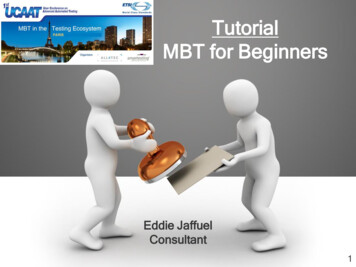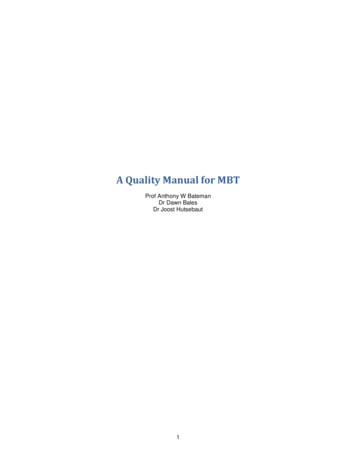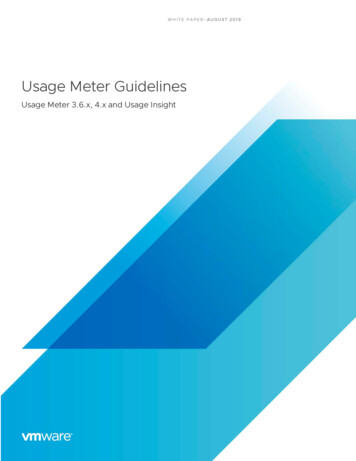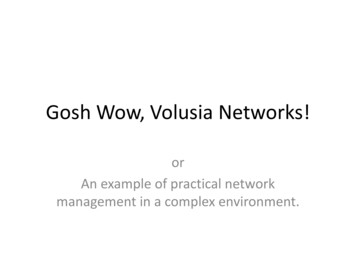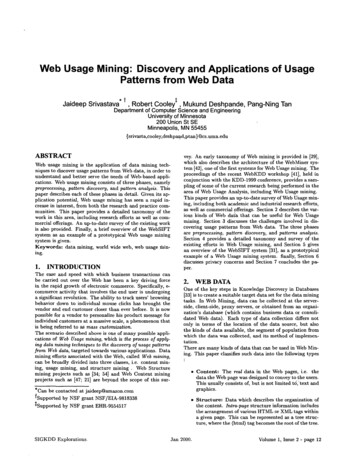
Transcription
TOWARDS THE USAGE OF MBT AT ETSIA Status Report of the ETSI Specialist Task Force 442for 8-th MBT Workshop 2013 – Rome, Italy ETSI 2011. All rights reserved
AgendaIntroduction Motivation STF 442Case Studies Overview GeoNetworking Case Study Modeling Test Generation EvaluationMethodology Outline MBT Process for Test StandardizationConclusions2 ETSI 2011. All rights reserved
MotivationMBT has matured into an industrial technology Successfully used in a wide range of application areasEnable MBT technology at ETSI ETSI Standard on model-based testing ETSI MBT User Conference Next Step: applying MBT in standardized test developmentGoals Assess feasibility Feedback on current MBT standard Create a methodology and process Determine next steps in MBT standardization3
STF 442Specialist Task Force initiated by ETSI MTSManpower 4 persons with 30 days each (120 working days total)Duration February 2012 – December 2012Expected Results Case Study Report Experiments with state of the art MBT tools Evaluation: MBT and ETSI test development ETSI MBT Methodology Guidelines Tool independent Outlining the usage of MBT at ETSI4
Overview of the Case StudiesTools Fraunhofer MDTester (academic) Conformiq Designer Microsoft SpecExplorer Sepp.med MBTsuiteCase Studies Academic Example Automated Teller Machine (ATM) GeoNetworking Protocol (ETSI TS 102 636) Intelligent Transportation Systems (ITS) Location service functionality of the GeoNetworking protocol Packet routing in ad-hoc networks, packet distribution in a geographical area Diameter Protocol (ETSI TS 129 214) UMTS, LTE, Rx interface Conveys session information and policy/charging rules between theApplication Function (AF) and the Policy/Charging Rules Function (PCRF)5
GeoNetworking Protocol OverviewVehicles exchange information with other vehicles, road infrastructure and Internet peers.Example usages Locating free parking lots Instant notifications Braking actions Road hazards Traffic conditions6 ETSI 2011. All rights reserved
Modeling (1/3)What is modeling? A sometimes simplified “mathematical description of a system orprocess, used to assist calculations and predictions”. – OxfordDictionaryModelSystemModeling7
Modeling (2/3)GeoNetworking Model Example (Conformiq Designer)Model consists of Graphical partForwarding Configuration Location service requestsand data transmission FSM Code part Message 8handlingInternal dataGeneratingresponse dataGuardconditionsBufferingRetransmission
Modeling (3/3)Challenges Expertise in protocol, tool and testing Choosing the right level of abstraction Dealing with complexityModels for GeoNetworking Case Study SpecExplorer C# code is mapped to an extended state machine Lower abstraction level than the Test Purposes Complete modeling, slicing Conformiq, MBTsuite, MD Tester 9Extended State Machines (Conformiq)Annotated UML State and Activity Diagrams (MBTsuite, MD Tester)Abstraction level of the Test PurposesSimplified modeling using Test Configurations
Test Generation (1/2)Influencing Test Generation Different modeling approaches lead to different test suites Each tool has different means to control test generationGenerating Tests for GeoNetworking Case Study SpecExplorer Coverage goals were selected requirements extracted from standard Conformiq Designer, MBTsuite, MDTester Coverage goals were based on standardized test purposes10
Test Generation (2/2)Example for generated tests in SpecExplorer11
Evaluation of Generated TestsTest Purposes (TP) were used for comparisonThe manually created TPs could be covered in all case studiesTools have also means to go beyond the TPsThe generated test cases were at least on the same level ofabstraction as the TPs12
Adaptation to Test EnvironmentSupport of Test Execution Possible to generate executable test cases with all tools 3 out of 4 tools have TTCN-3 supportTest Harness Adaptation to the target test system Adding of data not specified in the model, because it does notinfluence the test generation ParallelizationImproving Maintainability Parameterization Renaming of test cases, messages, variables etc. Re-structuring of test behaviour (e.g. preamble, test body, postamble)13
AgendaIntroduction Motivation STF 442Case Studies Overview GeoNetworking Case Study Modeling Test Generation EvaluationMethodology Outline MBT Process for Test StandardizationConclusions14 ETSI 2011. All rights reserved
Methodology OutlineModeling Identification of requirements Identification of modeling strategy Annotating models with references for requirements Modeling guidelines Model qualityAutomatic test generation Defining test coverage Generating test cases Quality of generated test casesTransformation and adaptation of generated test cases Transformation and adaptation steps Quality of adapted test suite15
MBT Process for Test StandardizationOutlineBase Standard SpecificationStandardCataloguing of RequirementsRequirementsCreation ofImplementation Check ListIdentification ofTest Group StructureSpecification ofTest PurposesTSSTPsSpecification ofTest DescriptionsTDsSpecification ofTest CasesTCsValidation16ICS/IFS
MBT Process for Test StandardizationOutlineBase Standard SpecificationStandardModeling for TestingCataloguing of RequirementsRequirementsCreation ofImplementation Check ListIdentification ofTest Group StructureSpecification ofTest PurposesICS/IFSTest ormationSpecification ofTest DescriptionsTDsSpecification ofTest CasesTCsValidation17Model
ConclusionsCase studies were successful with all tools All case studies have been modeled Abstract test cases were successfully generated Test coverage comparable with the manually designed test suiteMBT can be applied in standardized test development Additional validation of base standards and requirements MBT allows better control of test coverageChallenges Gather expertise in base standard, testing and modeling Abstraction gap between generated and manually written test cases Maintenance of test suite vs. maintenance of test model18
Contacting STF 442Jens Grabowski, University of Göttingen grabowski@informatik.uni-goettingen.deVictor Kuliamin, ISPRAS kuliamin@ispras.ruAlain-Georges Vouffo Feudjio, Thales alain-georges.vouffofeudjio@thalesgroup.comAntal Wu-Hen-Chang, Ericsson antal.wu-hen-chang@ericsson.comMilan Zoric milan.zoric@etsi.org19
ETSI and ETSI Specialist Task ForcesAbout ETSI: ETSI produces globally-applicable standards for Information andCommunications Technologies (ICT), including fixed, mobile, radio,converged, broadcast and internet technologies and is officiallyrecognized by the European Commission as a European StandardsOrganization. ETSI is a not-for-profit organization whose 700 ETSImember organizations benefit from direct participation and aredrawn from 60 countries worldwide. For more information, pleasevisit: www.etsi.orgAbout ETSI Specialist Task Forces (STF): STFs are teams of highly-skilled experts working together over a predefined period to draft an ETSI standard under the technical guidanceof an ETSI Technical Body and with the support of the ETSISecretariat. The task of the STFs is to accelerate the standardizationprocess in areas of strategic importance and in response to urgentmarket needs. For more information, please 20 ETSI 2011. All rights reserved
Modeling (3/3) Challenges Expertise in protocol, tool and testing Choosing the right level of abstraction Dealing with complexity Models for GeoNetworking Case Study SpecExplorer C# code is mapped to an extended state machine Lower abstraction level than the Test Purposes Complete modeling, slicing Conformiq, MBTsuite, MD Tester


